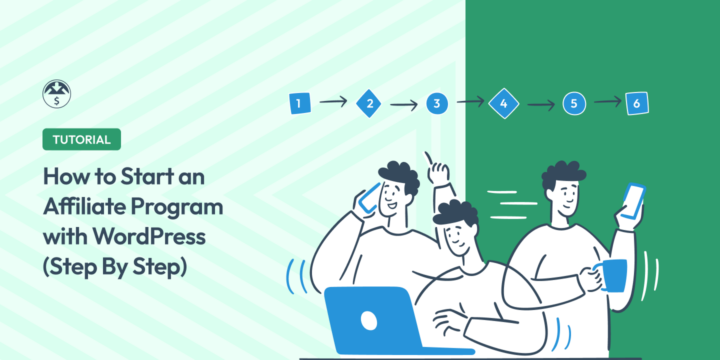
Building an online business is exciting, but it comes with challenges. One of the biggest concerns is how to promote your products effectively. Many entrepreneurs overlook how affiliate marketing can help them reach new customers without significant upfront costs.
Starting an affiliate program works because it allows you to connect with individuals or businesses eager to promote your products in exchange for a commission. I’ve seen companies succeed with this strategy, boosting their visibility and sales through partnerships.
Setting up an affiliate program in WordPress might sound complicated. But plugins like AffiliateWP make it easy. We even use it here at Easy Digital Downloads for our own affiliate program.
In this step-by-step guide, you’ll learn exactly how to set up, manage, and grow a successful affiliate program in WordPress.
What Is an Affiliate Program?
Affiliate marketing is like having a team of people who promote your products for you. It’s a performance-based marketing strategy where businesses reward affiliates for driving traffic to their website and increasing sales.
The goal could also be another desired action, such as signing up for a newsletter or filling out a form.
It’s one of the most cost-effective marketing strategies I’ve encountered. Instead of paying for traditional advertising upfront, you only pay when someone makes a successful sale.
Here’s how it works: You (the merchant) provide special tracking links to your affiliates. When someone clicks on these links and makes a purchase, the affiliate earns a commission.
Affiliate marketing programs are a win-win model for both merchants and affiliates. You gain exposure and sales; your WordPress affiliates earn a commission (typically a percentage of the sale or a fixed amount) for their marketing efforts and referrals.
💡 Learn more about affiliate and referral marketing.
Why Start an Affiliate Program for eCommerce?
Launching an affiliate program is a smart move if you want to boost revenue on your WordPress site.
Setting up a network of affiliate partners can drive sales, expand your reach, create a passive income stream, and build a strong brand presence in the eCommerce space.
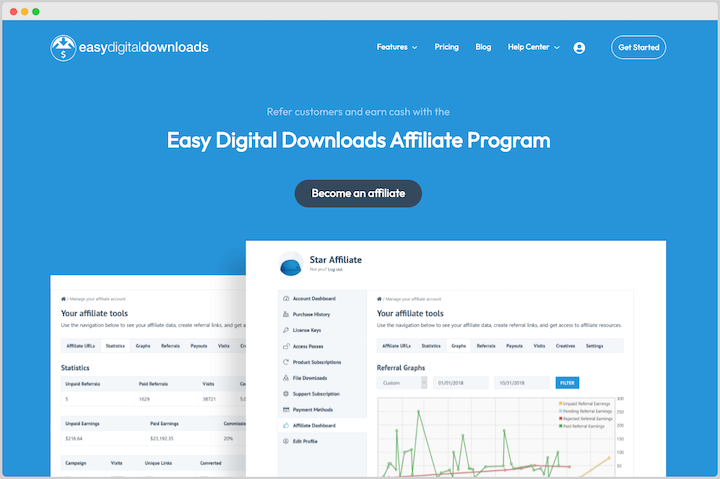
As an experienced digital marketer, I can tell you that affiliate marketing is particularly powerful for digital products and subscription-based services. Some of the reasons are that:
- There’s no inventory to manage
- Your profit margins can easily accommodate affiliate commissions
- Digital products are easy for affiliates to demonstrate and review
- The buying process is immediate
There are a handful of key benefits of affiliate marketing. Here’s why it makes sense for your online business.
- Expanded market reach. Affiliates promoting your products to their audiences can expand your reach, help you tap into new markets, and increase brand awareness.
- Cost-effective marketing. Few strategies guarantee results without any upfront costs. But affiliate marketing is performance-based, so you only pay commissions when affiliates generate sales. In other words, you only pay when you make money.
- Higher conversion rates. When affiliates share their genuine experiences with your products, it carries more weight than traditional advertising. Their audiences trust their recommendations, leading to higher conversion rates and sales.
- Improved SEO. Affiliates create content and backlinks to your site, which helps drive traffic and positively impacts your search engine rankings.
- Stronger relationships. Affiliate partnerships can facilitate long-term collaborations and mutually beneficial partnerships. They can also provide third-party validation to help build trust and credibility for your business with potential customers.
The best part is that you can easily set up a passive sales system. Once your affiliate program is created, it runs on autopilot. Your affiliates promote while you focus on improving your products and serving customers. It’s like having a 24/7 sales team that markets while you sleep.
Choosing the Best Affiliate Program Solution
Selecting the right tools is crucial to your affiliate program’s success.
Running an affiliate program without the right tools is like trying to manage a store without a cash register or inventory system. I’ve seen businesses struggle with spreadsheets and manual tracking. It’s messy and prone to errors.
Some of the most common headaches you’ll want to avoid:
- Managing affiliate relationships. Keeping track of dozens (or even hundreds) of affiliates can quickly become overwhelming. Each affiliate needs their own login, dashboard, and promotional materials.
- Tracking referrals accurately. Manual tracking is nearly impossible to get right, and missed referrals can quickly damage relationships with your best promoters.
- Processing payments: Nothing kills affiliate motivation faster than payment issues. You need a reliable way to calculate commissions, set payment thresholds, and process payouts on time.
- Maintaining security: Without proper security measures, you could end up paying commissions for sales that aren’t legitimate. Plus, you must protect your affiliates’ personal and payment information while complying with privacy regulations.
There are two main ways to start an affiliate program: third-party affiliate networks or your own website. I recommend opting for a self-hosted WordPress site.
Why Use an Affiliate WordPress Plugin?
When it comes to both eCommerce and affiliate marketing, managing your own self-hosted WordPress website gives you:
- Complete control over your site design and branding
- Flexible commission structures and payment options
- Direct relationship management with affiliates
- Detailed analytics and performance tracking
- Full ownership of your data and affiliate relationships
Third-party affiliate marketplaces, such as Amazon Associates, ClickBank, and ShareASale, can be useful for connecting small businesses with potential affiliates. But they come with limitations.
While these networks might seem easier to start with, they often cost more in the long run and limit your growth potential. You’ll have less control over commission structures, limited customization options, and higher fees and transaction costs.
Affiliate Program Prerequisites to Get Started
Before I dive into the step-by-step guide on setting up an affiliate program in WordPress, let’s ensure you have a few key things in place. Getting these foundations right will make the whole process smoother and help your affiliate program thrive from day one.
📋 Here’s what you’ll need:
Live, Self-Hosted WordPress Website
This is the absolute cornerstone. You need a WordPress.org (self-hosted) installation. For guidance, refer to How to Start a WordPress Online Store.
Ensure your website is live and accessible on the internet, not just a local development site.
Products or Services to Sell
It might sound obvious, but an affiliate program needs something for affiliates to promote! Make sure you have clearly defined products (physical or digital like eBooks, courses, software) or services that are ready for sale.
Your offerings should have clear pricing and be something you’re confident affiliates will want to share.
eCommerce Plugin
If you’re selling products, you’ll most likely need a functioning eCommerce plugin. The best plugin depends on what you sell.
- WooCommerce (physical products)
- Easy Digital Downloads (digital products, services)
- MemberPress (subscriptions)
- And many others
Ensure your checkout process is smooth and reliable. Affiliates will be sending traffic your way, and you want those clicks to convert.
Clearly Defined Affiliate Program Policies & Structure
- Commission Rate(s): Decide what you’ll pay your affiliates. Will it be a percentage of the sale (e.g., 10%) or a flat fee (e.g., $20 per sale)? You can set different rates for different products later, but have a starting point.
- Cookie Duration: How long after a click on an affiliate link will a referral be tracked for a potential commission? Common durations are 30, 60, or 90 days.
- Payment Methods & Schedule: Think about how you will pay your affiliates (e.g., PayPal, bank transfer) and how often (e.g., monthly, once they reach a minimum payout like $50).
- Basic Terms & Conditions: Even a simple outline of rules for your affiliates is crucial. What can they do? What can’t they do (e.g., bidding on your brand name in ads, using misleading claims)? This protects you and sets clear expectations. You can refine this later, but it’s good to start thinking about it.
(Recommended) Initial Branding/Promotional Assets
While not strictly necessary to install the plugin, having a few things ready can help your first affiliates hit the ground running. Consider preparing:
- Your logo
- A few standard banner sizes
- Some sample text or swipe copy they can use.
You can always add more later, but this shows you’re serious and makes it easier for affiliates to promote you from the get-go.
Commitment to Manage and Nurture Your Program
Launching an affiliate program isn’t a “set it and forget it” task. Be prepared to invest time in:
- Reviewing and approving affiliate applications.
- Communicating with your affiliates.
- Processing payouts.
- Monitoring performance and looking for ways to improve.
How to Start an Affiliate Program in WordPress
Ready to get to work? There are a handful of affiliate marketing WordPress plugins out there. Some popular options include Thirsty Affiliates, Easy Affiliate, and AffiliateWP.
Below, I’ll show you how to start an affiliate program in WordPress using the AffiliateWP plugin.
Step 1. Install AffiliateWP
Getting AffiliateWP up and running on your WordPress site is straightforward. Head to the AffiliateWP website, click Get AffiliateWP Now, and choose your plan.
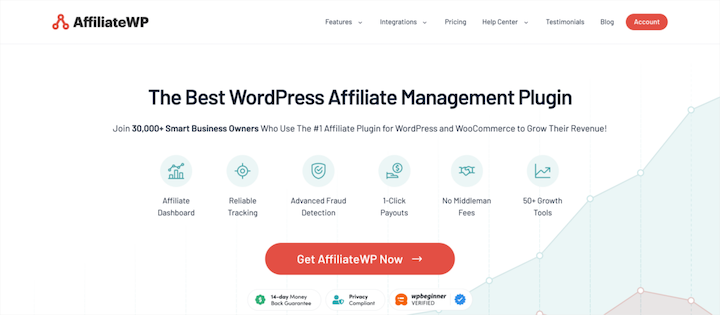
Since we’re integrating with Easy Digital Downloads, I recommend the Pro plan to access the features you’ll need most, like multiple payment integrations, recurring referrals tracking, etc.
Once you complete your purchase, you’ll receive an email with your login credentials.
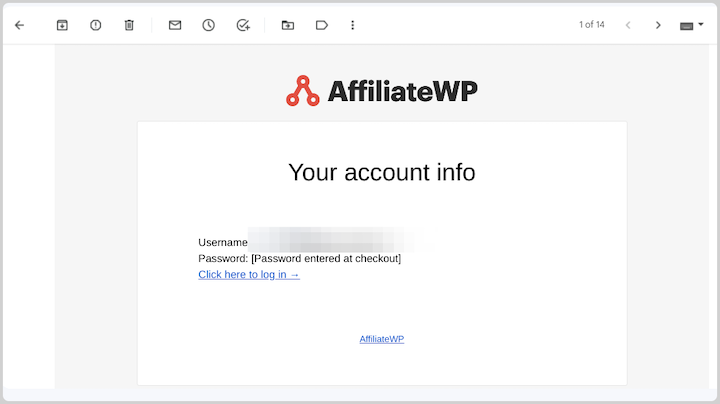
From your account dashboard, select Download AffiliateWP. Then copy the license key, found to the left of the screen.
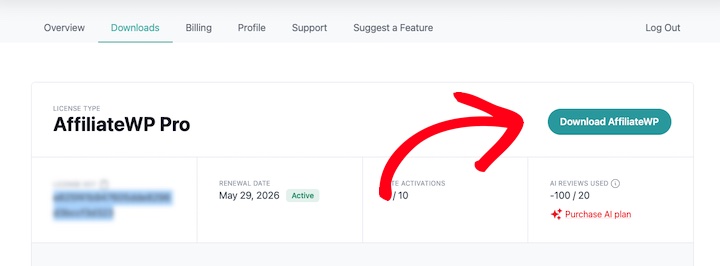
From your WordPress dashboard, go to Plugins » Add Plugin » Upload Plugin. Click on Choose File and upload your AffiliateWP zip file.

Select Install Now followed by Activate Plugin. Upon activation, you’ll see a new Affiliates menu item in your WordPress dashboard.
Hover your cursor and select Settings. Under General » License Settings, paste your license key and click Active License.

At the bottom of the page, select Save Changes.
Step 2. Launch & Configure the Setup Wizard
Under where you enter your AffiliateWP license key, select Launch Setup Wizard.
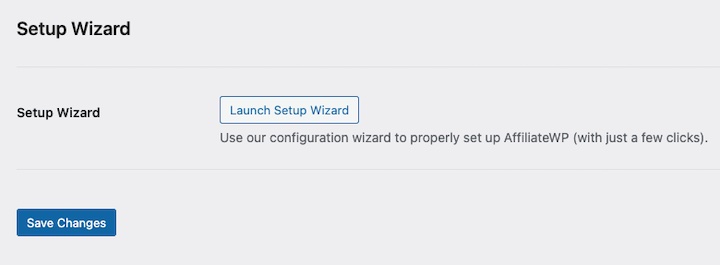
The Setup Wizard walks you through the essential configurations. After the license key activation, select the WordPress plugins you want to integrate with AffiliateWP.
I’ll select Easy Digital Downloads. If you’ve already installed and activated the eCommerce plugin, this option should be selected by default.
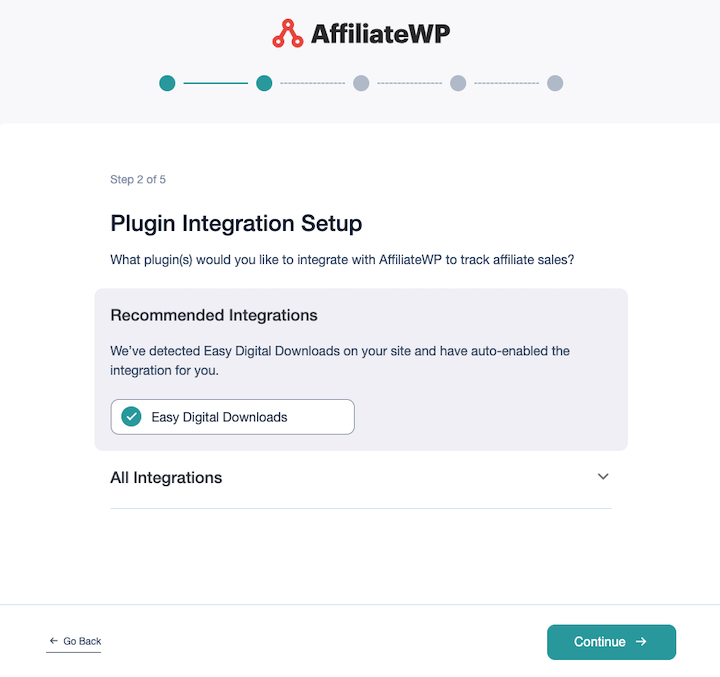
You can click to expand the All Integrations panel to explore and connect additional plugins. Then select Continue to move to the third screen.
On the Affiliate Payouts page, you can adjust settings for how your affiliates receive commissions. For now, feel free to leave the default settings as is.
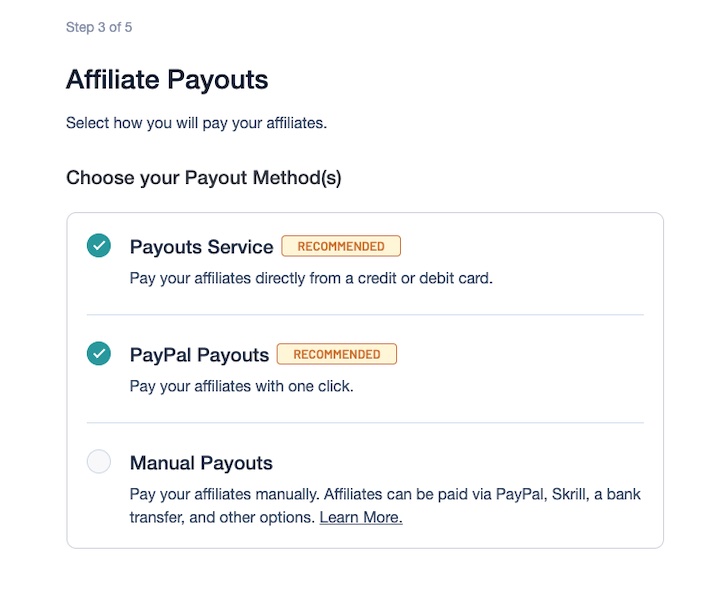
Next is Commissions and Growth Tools.

These settings let you choose the currency for your store and enter the percentage amount of commission for your affiliates to receive (the default is 20%). Again, these options can always be changed later.
The last screen of the Setup Wizard summarizes your setup. Click on Finish Setup and Exit to complete the process.
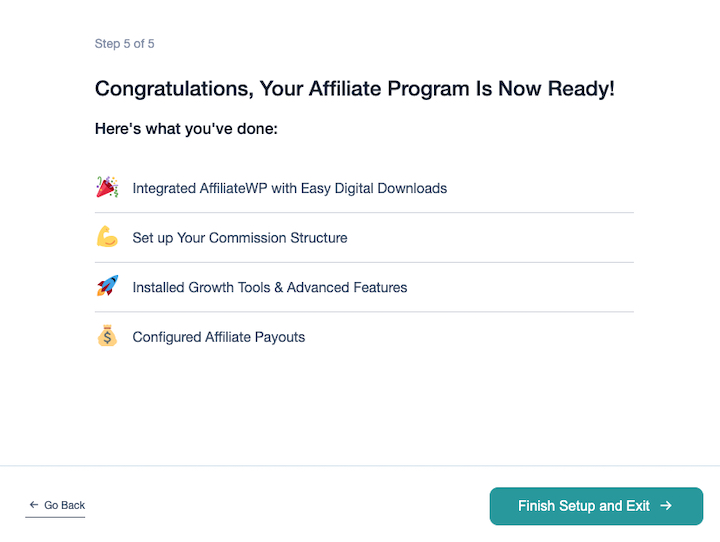
Beyond the Setup Wizard, you can visit the General settings tab anytime to find and/or modify just about any aspect of your affiliate program, including your Terms of Use, referral rate, cookie expiration, and payout option.
I’ll expand on some of these options in the following steps. But for more detailed guidance and instructions on all AffiliateWP settings, you can check out the comprehensive AffiliateWP Getting Started documentation.
Step 3. Set Up Affiliate Registration
The next order of business is to configure the affiliate registration. This is where affiliates go to complete the registration form for your affiliate program and, if accepted, log in.
The affiliate registration process is your first line of defense against low-quality affiliates and potential fraud. I’ve learned that getting this right makes managing your program much easier down the road.
AffiliateWP automatically creates pages for the Affiliate Area, which is a dashboard for your affiliates, and a registration and login form. These pages are assigned under Settings » Affiliates.

To view and edit the registration form, go to AffiliateWP » Setup. Next to Create Your First Affiliate Form, click Edit Form.
You can also add and edit the form using the Affiliate Registration block. To the right, you can select the toggle to make form fields required.
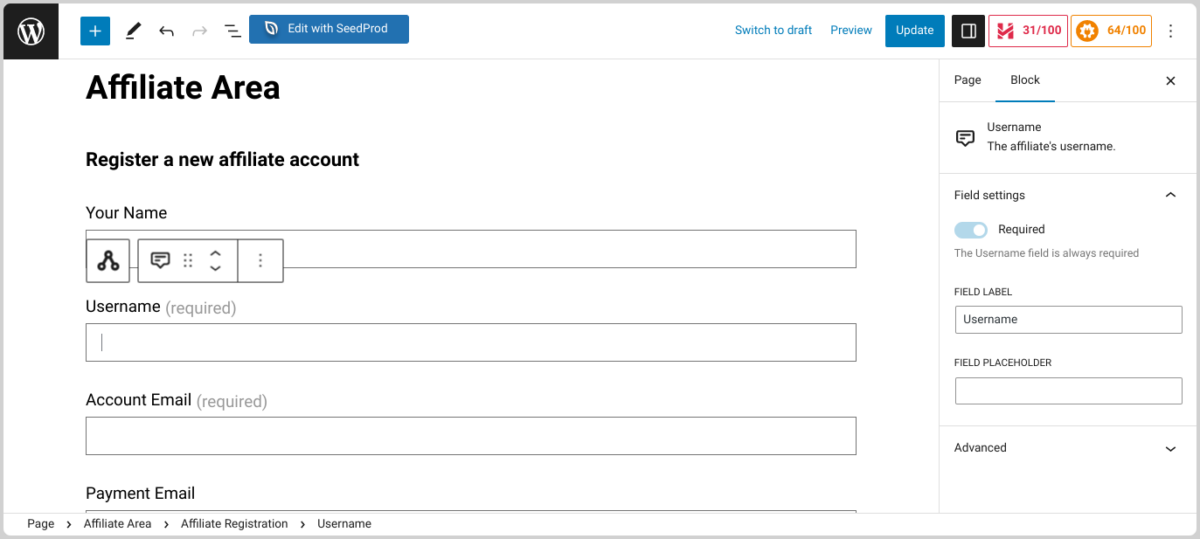
On the Settings » Affiliates screen, enable the Allow Affiliate Registration option.

By default, AffiliateWP settings require you to manually approve affiliate registrations. This can be important for maintaining the quality and integrity of your affiliate program. You want to make sure anyone joining is a good fit.
However, if you wish to change it to auto-approve registrations, simply deselect the option.
There’s also a feature for AI affiliate application review.
On the Settings » Affiliates screen, there are a handful of additional options.
Under Affiliate Links, you can change the default link format and configure the link sharing options.
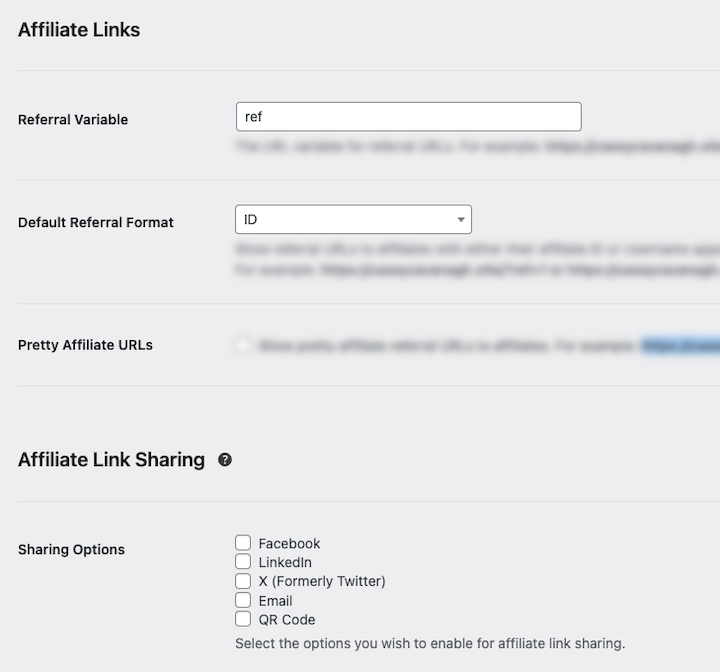
Under the Affiliate UI section, you can enable the logout link option.
You can also enable Affiliate Landing Pages. This will automatically install an addon that lets you create custom landing pages for affiliates to promote without having to share affiliate links.
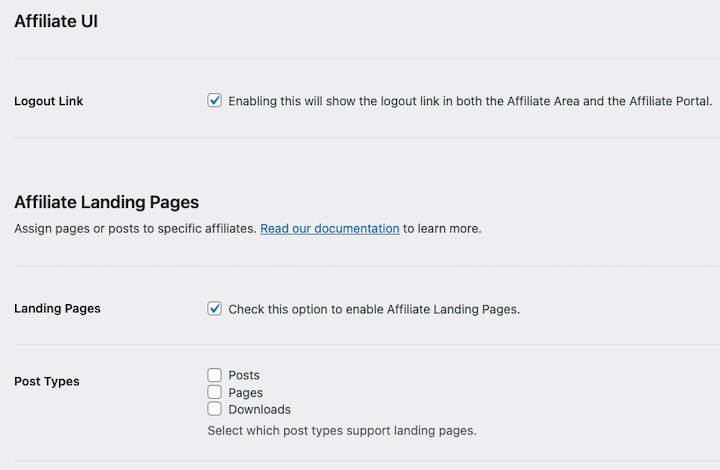
Be sure to save your changes when you’re done.
Step 4. Configure Commissions & Payouts
Next, move to the Settings » Commissions tab. This is where you can control how affiliate commissions are calculated and distributed.

Setting the right commission structure can make or break your affiliate program. Through years of managing affiliate programs, I’ve found that a well-thought-out commission strategy keeps affiliates motivated while maintaining healthy profit margins.
Setting Your Base Rate
You can set your Referral Rate and default Referral Rate Type.
Your default commission rate serves as the foundation of your program. For digital products, I typically recommend starting between 20% and 30%. This rate hits the sweet spot – it’s attractive enough to motivate affiliates while leaving room for profit after accounting for payment processing fees and operating costs.
By default, the Cookie Expiration is set to 3, which is recommended.
Product-Specific Commissions
Not all products need the same commission rate. For instance, you might offer a higher percentage on your flagship course to drive more promotions, or a lower rate on products with tight margins.
Through the Easy Digital Downloads integration, you can set unique commission rates for each product. Navigate to Downloads » Downloads and edit the product you want to customize.
Look for the Affiliate Rates section (usually in the Download Settings meta box)

Here you can override the default commission rate for this specific product.
Payout Methods
Further down on the AffiliateWP Commissions settings page, you’ll find Payout Methods. This is where you configure the payouts for your affiliates.
By default, you can use PayPal or manual methods.
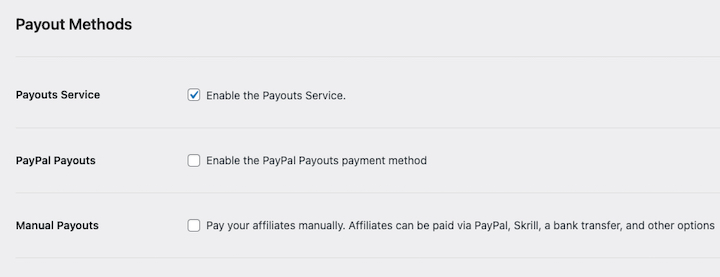
Another option is to use the AffiliateWP Payouts Service. I recommend doing this if you want to pay via bank transfer/directly from debit or credit cards.
After you enable the Payout Service option, you can follow the AffiliateWP payout services instructions on connecting your account.
Later, your affiliate recruits can sign up for direct payments to their bank accounts directly from the Affiliate Area.
Toward the bottom of the Commissions settings screen, you can find options for advanced tools (if you installed them during setup). This includes multi-currency and multi-tier commissions.
Step 5. Customize the Affiliate Area
As I mentioned, the Affiliate Area is the dashboard for your affiliates. It’s basically like their centralized hub.
It’s where they go to generate affiliate links, monitor analytics, track payouts, and more. It’s also where they’ll find the creatives you share for them to promote, such as landing pages, graphics, etc.
There are a lot of settings to cover here, and ways to customize them. I recommend reviewing AffiliateWP’s documentation for a full rundown.
To offer your affiliates an even more intuitive interface, I recommend installing the Affiliate portal addon.
Go to AffiliateWP » Settings » Affiliate Portal. Click the checkbox to Enable the Affiliate Portal.
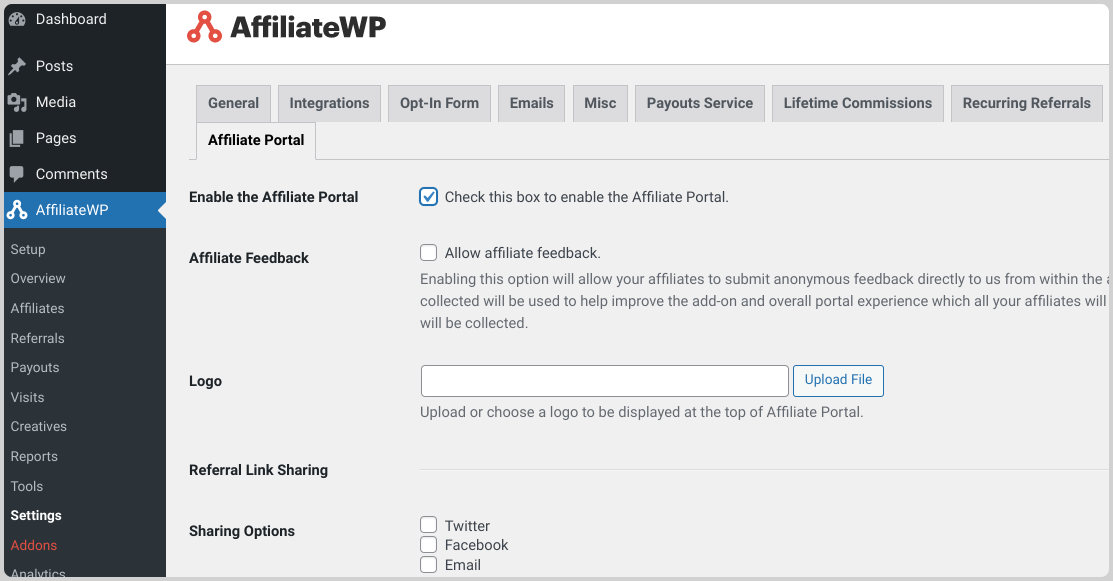
You can configure the link sharing options, email sharing messages, creatives per page, and more.
Once set up, your affiliates can access their Affiliate Area dashboard to generate referral URLs, download creatives, and more.

Under AffiliateWP » Creatives, you can add the marketing materials you’ll provide affiliates to promote your products.
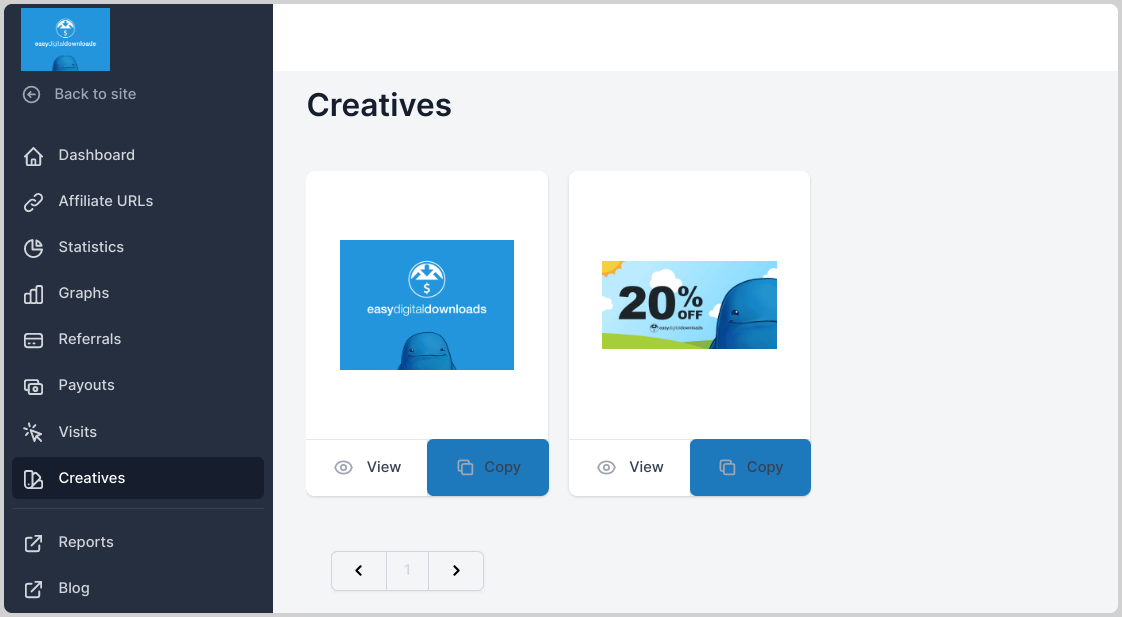
Your affiliates need clear records of their earnings and payments. AffiliateWP automatically generates payment histories, but take time to ensure they’re detailed enough.
Under Settings » Emails, you can configure some of the affiliate email options.
This includes which affiliate actions and activities you receive email notifications for.

Remember to save your changes when you’re done.
Step 6. Test Your Affiliate Program in WordPress
Testing might not be the most exciting part of setting up your affiliate program, but it’s absolutely crucial. Testing prevents headaches down the road.
Start by setting up a complete test scenario. Create a test affiliate account just like a real affiliate would experience it. Go through the registration process, check the approval emails, and log into the affiliate dashboard.
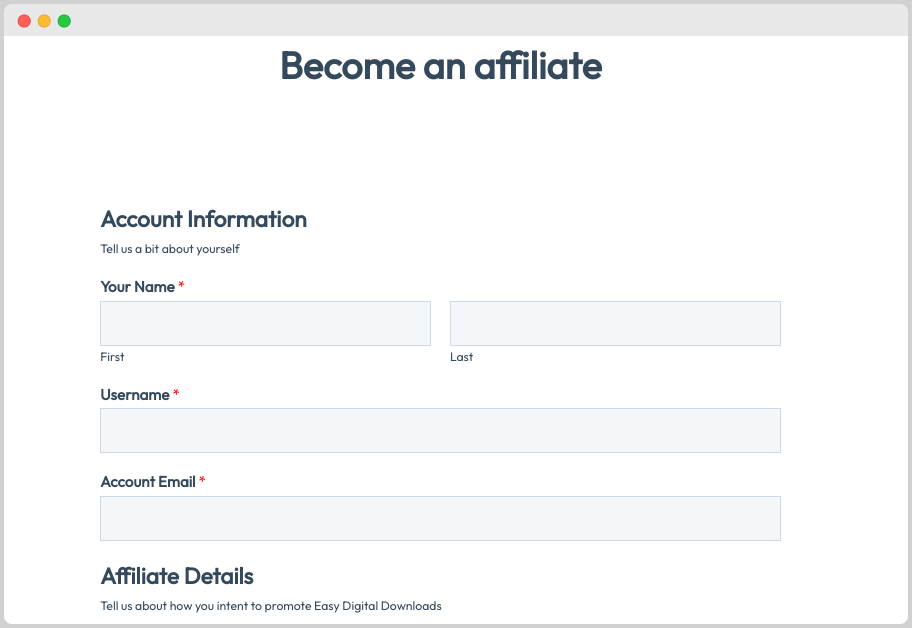
Since you’re in the beginning stages of learning how to start an affiliate program with WordPress, you likely don’t have any affiliates (yet!). That’s okay. AffiliateWP lets you add yourself as one to preview and test how the system works.
Under the AffiliateWP » Setup screen, click Add Affiliate, followed by Edit Affiliate.
Preview what the page for adding a new affiliate looks like. Yours will have your own information auto-completed in the fields.
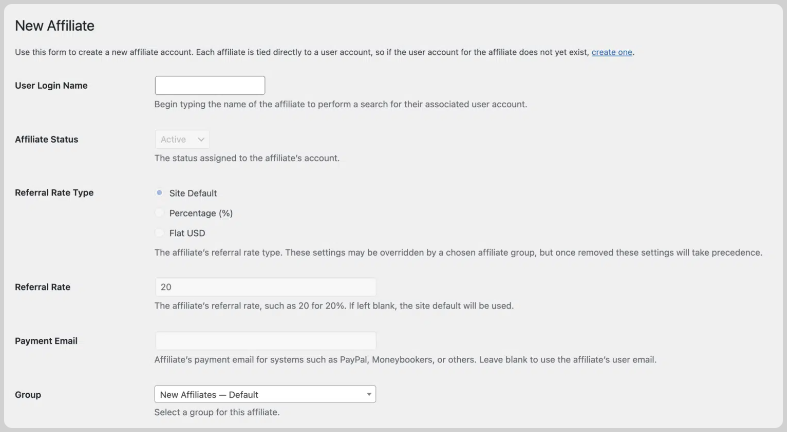
Generate an affiliate link from your test account and make some test purchases. I recommend running through several different scenarios:
- First, make a straightforward purchase right after clicking the affiliate link. This tests your basic tracking.
- Then wait a few hours between clicking and purchasing. This ensures your cookie duration works correctly.
- Finally, try more complex situations like abandoned carts or multiple affiliate links.
Before launching, perform one final end-to-end test. Pretend you’re a completely new affiliate and go through every step of the process:
- Finding your affiliate program
- Reading the terms and conditions
- Submitting an application
- Receiving approval
- Accessing marketing materials
- Making test referrals
- Checking statistics
- Requesting payment
Look for anything that might confuse or frustrate a new affiliate. Remember, your goal is to make it as easy as possible for affiliates to succeed.
Recruiting Affiliates to Your Program
Once your affiliate program is set up, recruitment is key. Consider these strategies:
- Promote to your existing audience: Announce your program to your email list, social media followers, and website visitors. Your loyal customers can be your best advocates.
- Create a dedicated affiliate page: Make it easy for potential affiliates to find information about your program, its benefits, commission rates, and a sign-up link.
- Reach out to relevant bloggers and influencers: Identify individuals in your niche whose audience aligns with your products/services and personally invite them to join.
- Utilize affiliate networks (optional): While WordPress plugins allow you to run your own program, larger networks can offer wider reach but come with their own fees and rules.
- Offer competitive commissions and incentives: Ensure your commission structure is attractive compared to competitors. Consider bonuses for top performers.
Tips for a Successful Affiliate Program in WordPress
Affiliate program success often comes down to the details. Here are some insider tips that can make a big difference in your program’s performance.
Build Strong Affiliate Relationships
The most successful affiliate programs I’ve seen treat their affiliates like business partners, not just promotional channels. Schedule regular check-ins with your top performers. Send them early access to new products. Ask for their feedback on your program. These personal touches build loyalty and encourage more active promotion.
Remember to celebrate your affiliates’ successes. When someone hits a milestone – their first sale, a record month, or consistent performance – acknowledge it. A personal email or small bonus can go a long way.
Create Effective Promotional Materials
Don’t just give affiliates a link and wish them luck. Create resources that make it easy for them to promote successfully. I’ve found that providing a variety of materials works best because every affiliate has different promotional strengths.
Write compelling email swipe copy that they can customize. Create social media images in multiple sizes. Record video tutorials about your products. The easier you make it for affiliates to promote effectively, the better results you’ll see.
💡 Tip: Update your promotional materials regularly, especially around product launches or seasonal promotions. Fresh content gives affiliates new reasons to share your products.
Manage Commission Structures Strategically
Your commission structure should evolve with your program. Start with competitive base rates, but consider adding performance bonuses as you grow.
For instance, you might offer an extra 5% when affiliates exceed $1,000 in monthly sales, or provide bonuses for consistently high conversion rates.
Create a clear, dedicated page explaining your commission structure to potential affiliates. Include real examples showing earning potential, payment schedules, and any special incentives.
Being transparent about your commission structure builds trust and helps affiliates decide if your program is right for them.
Don’t forget about special promotions. Running temporary commission increases during product launches or slow periods can reinvigorate your affiliate base and drive additional sales.
Maintain Program Security
Keep an eye on affiliate activity patterns. Watch for red flags like unusually high conversion rates or traffic from suspicious sources. AffiliateWP’s reporting tools can help identify potential fraud, but human oversight is still important.
Regular audits of your affiliate base help maintain program quality. Remove inactive affiliates after sending warning emails. Update your terms and conditions as needed to address new promotional methods or challenges that arise.
Grow Your Program
Once your program is running smoothly, focus on recruitment. Your existing customers often make great affiliates; they already know and love your products. Consider adding an affiliate invitation to your post-purchase emails.
Network in your industry. Attend relevant conferences. Join online communities where potential affiliates gather. But remember, quality matters more than quantity. One engaged, professional affiliate usually outperforms dozens of inactive ones.
FAQs on Affiliate Programs in WordPress
Let’s wrap up with some frequently asked questions about affiliate marketing and how to start an affiliate program in WordPress.
What’s the easiest way to start an affiliate program in WordPress?
The most straightforward method is to use a dedicated WordPress affiliate marketing plugin. These plugins handle the core functionalities like affiliate registration, link tracking, commission calculations, and payouts. Popular choices include AffiliateWP and Easy Affiliate.
- Steps typically involve:
- Choosing and installing your preferred plugin.
- Configuring basic settings: commission rates (percentage or flat fee), cookie duration, and payout methods.
- Setting up an affiliate registration page and dashboard.
- Providing marketing assets (banners, links) for your affiliates.
- Monitoring performance and managing affiliates through the plugin’s interface.
Using a plugin significantly simplifies the technical aspects, allowing you to focus on recruiting affiliates and growing your program.
Can I start an affiliate program in WordPress for free?
While some plugins offer very limited free versions or trials, creating a robust and fully functional affiliate program on WordPress typically involves a cost, primarily for a premium affiliate management plugin. Free options might lack crucial features like advanced tracking, fraud detection, payout management, or sufficient customization.
However, you can minimize initial costs by starting with the entry-level tier of a reputable paid plugin. Also, focus on organic affiliate recruitment initially.
Investing in a quality plugin is generally recommended for scalability, reliability, and comprehensive features that will save you time and effort in the long run.
What are common pitfalls of starting an affiliate program?
Setting up an affiliate program can be challenging. One common issue is choosing the wrong plugin, leading to complicated setups and unsatisfied affiliates. Another potential pitfall is failing to define program terms, causing confusion and trust issues clearly. It’s crucial to ensure you select a reliable plugin and clearly communicate program guidelines from the onset.
What should I look for in an affiliate program plugin?
When selecting an affiliate plugin for WordPress, prioritize these essential features:
- Integration: Seamless integration with your eCommerce platform (e.g., WooCommerce, Easy Digital Downloads) and email marketing services.
- Accurate tracking: Reliable tracking of clicks, conversions, and commissions is fundamental. Look for options like unique affiliate links and coupon code tracking.
- Easy sffiliate management: A user-friendly dashboard for both you (to manage affiliates, view reports, process payouts) and your affiliates (to track their earnings and get links).
- Customizable commission structures: Flexibility to set different commission rates (percentage, flat fee), recurring commissions, or performance-based tiers.
- Payout management: Integrated or easy-to-use systems for handling affiliate payouts (e.g., PayPal integration, Stripe).
- Marketing creatives management: Ability to upload and provide banners, text links, and other promotional materials for your affiliates.
- Reporting and analytics: Detailed reports on traffic, sales, top affiliates, and overall program performance.
Start Your Affiliate Program in WordPress
Creating an affiliate program with WordPress using AffiliateWP and Easy Digital Downloads is a strategic move to boost your e-commerce business.
By harnessing the power of affiliate marketing, you can expand your reach, increase sales, and build valuable partnerships within your industry.
Still need to set up your e-commerce store? Grab an Easy Digital Downloads pass to get started, then integrate with AffiliateWP within a matter of minutes:
📣 P.S. Be sure to subscribe to our newsletter and follow us on Facebook, Twitter/X, or LinkedIn for more WordPress resources!
Using WordPress and want to get Easy Digital Downloads for free?
Enter the URL to your WordPress website to install.
Disclosure: Our content is reader-supported. This means if you click on some of our links, then we may earn a commission. We only recommend products that we believe will add value to our readers.
3 comments
Comments are closed.
Hi, Thanks for sharing your knowledge. This was really helpful article
That’s Great Value there, Thank You ! 🙂
btw are you interested to make an affiliation with https://speedly.link ?